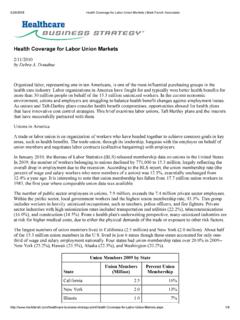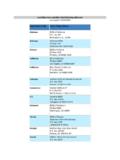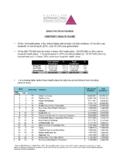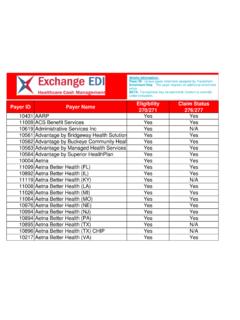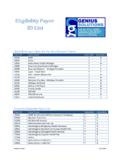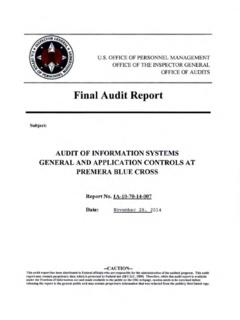Transcription of Blue Cross and Blue Shield Market Share Snapshot …
1 5/29/2018 blue Cross and blue Shield Market Share Snapshot 2015 | Mark Farrah Cross and blue Shield Market Share Snapshot 20151/26/2016 by Mark Farrah Associates For decades, blue Cross and blue Shield plans have been health insurance leaders and the Blues brand continuesto generate broad-based Market appeal to this day. Thirty six independent blue Cross and blue Shield companiescurrently operate across the 50 states, the District of Columbia and territories, providing health insurancecoverage and related benefits for millions of Americans. As of September 2015, Blues plans and affiliatesprovided comprehensive medical coverage for million members, representing 41% of the total healthinsurance Market .
2 This speaks to the influence blue Cross and blue Shield plans wield in the healthcare industryboth politically and economically. According to the blue Cross blue Shield Association, Blues plans areaccepted by more than 90% of doctors and specialists nationwide. Furthermore, these plans serve 85% ofFortune 100 companies and 76% of Fortune 500 this analysis brief, Mark Farrah Associates (MFA) will look at the latest Blues plan Market Share and assessrecent membership trends and overall growth among the 36 licensed blue Cross and blue Shield blue Cross blue Shield OrganizationsBlue Cross and blue Shield organizations (BCBS or Blues) are the nation's oldest and largest family of healthinsurance companies.
3 The Blues consortium first pioneered the concept of health insurance in the early 1900sand there is a wealth of information about the history and current state of blue Cross and blue Shield on theAssociation website ( ). In the early formative years, health insurance was a completelyinnovative approach to address a dire need in the blue Cross and blue Shield began with the simpleconcept of pooling resources of a local community, the power of everyone's premiums together, so people couldcollectively afford to pay for health organizations historically operated as independent companies generally in single-state territories, but thebusiness scenario has changed considerably in the last 20 30 years.
4 Now many Blues companies haveoperations in more than one state and it is not uncommon for companies to offer both Blues branded and non-Blues products. Two large companies, Anthem (formerly WellPoint) and Health Care Service Corporation(HCSC), are known as key Blues consolidators in the industry. Anthem, the Blues leader with almost 31 millionhealth members, currently has key operations in 14 states and is seeking regulatory approval to acquire Cigna,which will extend its footprint considerably. HCSC, a mutual insurance company owned by its policyholders,currently operates Blues plans in 5 core states (Illinois, Montana, New Mexico, Oklahoma and Texas).
5 Severalother blue Cross blue Shield companies offer health plans within a region of two or more states, such asCambia, CareFirst, Highmark, Independence blue Cross , Premera and blue Cross blue Shield plans continue to operate in single-state territories and several of these plans havebeen focused on diversifying their business to remain competitive as the industry changes. As non-profits,single-state Blues plans generally find it more difficult to obtain capital funding needed for strategic initiatives tokeep up with the publicly-traded leaders in the industry. Industry pressures may compel additional single-stateBlues to consider merging with a larger Blues company to gain economies of scale.
6 A recent transaction of thisnature closed in mid-year 2015 when blue Cross of Northeastern Pennsylvania opted to merge with the most part, Blues plans like other key competitors in the industry already have non-BCBS licensedsubsidiaries or they themselves are affiliates of a much larger organization. As provider payment models are5/29/2018 blue Cross and blue Shield Market Share Snapshot 2015 | Mark Farrah in line with the emergence of ACOs (Accountable Care Organizations) and other payer-providerinitiatives, Blues companies, like the rest of the industry, are creating innovative joint ventures with Cross blue Shield Market ShareBy virtue of Market Share and strongholds in local communities, the Blues brand gives plans a significantcompetitive advantage.
7 blue Cross and blue Shield companies continue to have a significant presence in everystate and territory. Blues plans typically have diversified product portfolios with commercial, Medicare andMedicaid business along with specialty benefits, dental, Medicare Supplement. Many have retained sizeablehealth benefit accounts with local municipalities as well as state and local assessment of comprehensive medical membership by state, as of September 2015, reveals that blue Crossand blue Shield companies and affiliates command more than 60% of the health insurance Market Share in 10states, up from 9 states at the same point in 2014.
8 This is based on an assessment of combined Bluesmembership (both branded and non-branded plans) compared with aggregate membership counts of non-Bluesbusiness by state. The comprehensive medical membership figures used for this assessment included Individual,Group Risk, Group ASO, FEHBP (Federal Employees Health Benefits Program), Medicare Advantage andManaged Medicaid segments. Note this includes membership for the Triple S Salud plan in Puerto Rico andgiven that 3Q15 enrollment was unavailable, 2Q15 figures were 10 states, Blues companies have collectively retained a 50 to 59% Share of the Market and Blues Market shareranged from 40 to 49% in another 14 states.
9 For 17 states plus the District of Columbia, blue Cross and BlueShield business represents local Market shares ranging from 20% to 39%. On occasion, the dominant presence of5/29/2018 blue Cross and blue Shield Market Share Snapshot 2015 | Mark Farrah plans in state markets has been challenged by an industry stakeholder as being anticompetitive ormonopoly-like. This review did not entail in-depth analysis to measure levels of competition. Yet, healthinsurance choices in the vast majority of states include plans offered by Blues, national carriers, and regional,non-Blues plans which suggests competition is reasonably healthy in most Membership ObservationsAs of September 2015, Blues plans and affiliates provided insurance or administered benefits for millionpeople through major medical plans, reflecting a membership increase year-over-year.
10 Approximately halfof the Blues aggregate membership is through self-funded or administrative services only (ASO) percent of Blues membership is Group (risk-based), nine percent of total membership is Individualand 8% is Medicaid. FEHBP comprises 5% of the aggregate Blues book and the balance of 3% is MedicareAdvantage Cross and blue Shield Market Share Snapshot 2015 | Mark Farrah the growth experienced due to the surge of ACA marketplace related medical membership in 2014, from3Q14 to 3Q15, Blues organizations as an aggregate saw an overall increase in total medical in 2014, The Blues realized moderate gains in ASO business while the Group (risk-based) segmentexperienced a decline.
